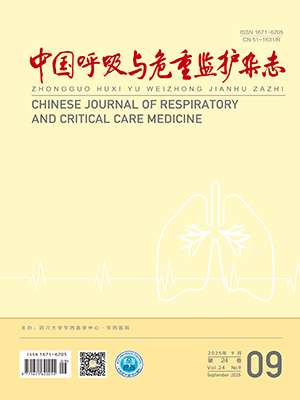Objective To investigate the clinical characteristics and treatment for Type II pulmonary vascular anomaly ( pulmonary arteriovenous malformations) of hepatopulmonary syndrome ( HPS)presenting with hemothorax. Methods A case of Type II pulmonary vascular anomaly of HPS presenting with recurrent hemothorax was described. The clinical data was analyzed and the related literature was reviewed. Results A 72-year-old male patient with Type II pulmonary vascular dilatations of HPS was described to present with recurrent dyspnea and encapsulated pleural effusions. After 4 procedures of thoracentesis, a total of 2510 mL of bloody pleural effusions was drained. The routine analysis of pleural fluid showed the count of red cells exceeded 100 ×109 / L, whereas cytologic examination and tumor biomarkers were negative. Then CTPA and pulmonary angiogramrevealed a Type II pulmonary vascular anomaly of HPS combined with hemothorax. The PaO2 of arterial blood in upright and supine position was 58. 3 mm Hg and 66. 3 mm Hg, respectively. Hypoxemia was alleviated and hemothorax was controlled after embolization of malformed blood vessels. Fromliterature review, similar cases of hemothorax resulted fromrupture of Type II pulmonary vascular anomaly of HPS were not reported. The primary clinical manifestations of HPS were dyspnea and cyanosis. Orthodeoxia and platypnea were most consistent with HPS. The best screening tool for hypoxemia in patients with HPS was P( A-a) O2. The characteristic findings of HPS on chest CT was a lesion or reticulonodular opacities occurring predominantly in the bases of the lungs, which could be enhanced by contrast medium. Pulmonary angiogram was necessary to identify the types of pulmonary vascular dilatations. Hepoxemia of patients with Type II HPS often responded poorly to oxygen therapy, whereas embolization of the pulmonary arteriovenous fistulas was helpful to improve anoxia. Conclusions Rupture of
Type II pulmonary vascular malformations in HPS was a rare cause of hemothorax. Thrombosis of pulmonary arteriovenous malformations may result in significant improvement in oxygen saturations as well as control of hemothorax. In the setting of liver disease, intrapulmonary vascular dilatations and hypoxemia often suggest
the existence of HPS.
Citation: JIN Jianmin,SUN Yongchang,CHEN Dongning,LIU Xiaofang,LIANG Xihong.. Type II Pulmonary Vascular Anomaly of Hepatopulmonary Syndrome Presenting with Hemothorax:A Case Report and Literature Review. Chinese Journal of Respiratory and Critical Care Medicine, 2010, 9(1): 61-65. doi: Copy
Copyright © the editorial department of Chinese Journal of Respiratory and Critical Care Medicine of West China Medical Publisher. All rights reserved




